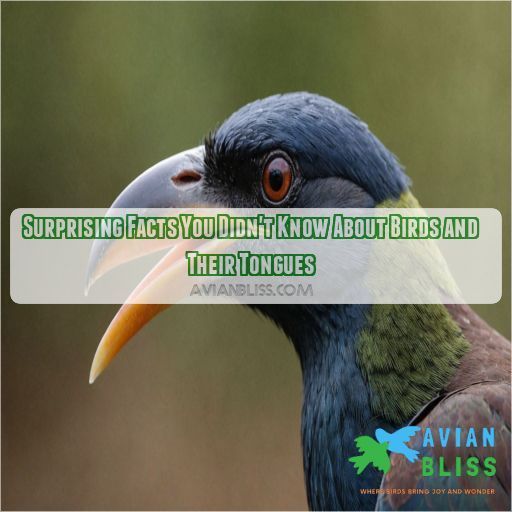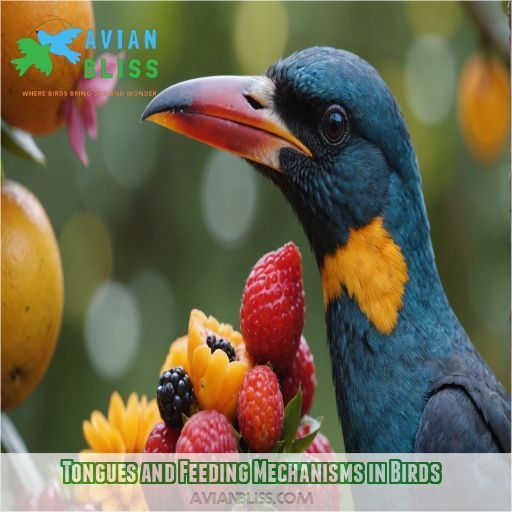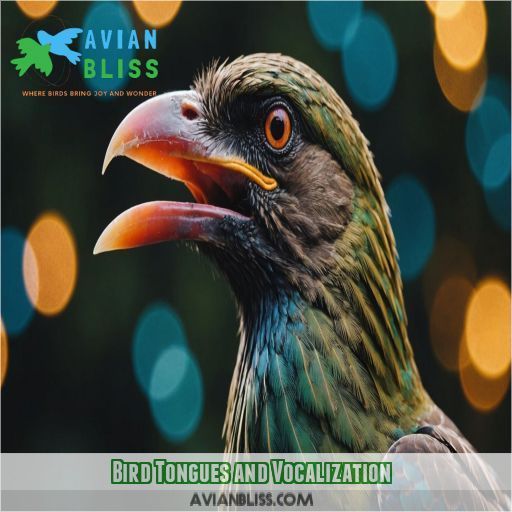This site is supported by our readers. We may earn a commission, at no cost to you, if you purchase through links.

The variety of bird tongues is quite remarkable, from the long, barbed tongues of woodpeckers used to fish out bugs from tree bark, to the tiny, almost useless tongues of Flightless birds.
These tongues help birds do all sorts of amazing things, like manipulating food, producing complex vocalizations, and even grooming.
While some birds may have lost or reduced their tongues over time, the vast majority of our feathered friends are masters of tongue dexterity.
Table Of Contents
- Key Takeaways
- Do Birds Have Tongues?
- Specialized Tongues of Woodpeckers
- Tongues and Feeding Mechanisms in Birds
- Bird Tongues and Vocalization
- Sensory Functions of Bird Tongues
- Do All Birds Have Tongues?
- Interesting Facts About Bird Tongues
- Frequently Asked Questions (FAQs)
- Do blue jays have tongues?
- Do birds use their tongues to sing?
- Do birds have teeth and tongues?
- Do cardinals have tongues?
- How do bird tongues assist in flight?
- Do all bird tongues have similar structure?
- How do bird tongues aid in courtship displays?
- Can bird tongues be used for self-defense?
- How do bird tongues evolve over a lifetime?
- Conclusion
Key Takeaways
- Birds do have tongues, but they’re quite different from the fleshy, flexible human tongue. Avian tongues come in a variety of fascinating shapes and sizes, each uniquely adapted to a bird’s specific feeding and vocalization needs.
- A bird’s tongue is essential for all sorts of amazing things, like manipulating food, producing complex vocalizations, and even grooming. From nectar-sipping hummingbirds to insect-extracting woodpeckers, a bird’s tongue is a true multi-tool of the avian world.
- Not all birds have fully developed tongues; some species, like flightless birds, have evolved to lose or greatly reduce this feature over time. But for the vast majority of our feathered friends, their tongues are true marvels of natural adaptation.
- Bird tongues are packed with surprises! From their unique anatomy and structure to their cultural significance, these feathered appendages are way more fascinating than you might think. Get ready to see your backyard birds in a whole new light!
Do Birds Have Tongues?
Do Birds Have Tongues? You might be surprised to learn that birds do indeed have tongues, but they’re quite different from the fleshy, flexible tongues humans possess. Avian tongues come in a variety of fascinating shapes and sizes, each uniquely adapted to a bird’s specific feeding and vocalization needs.
Tongue Structure in Birds
You may not realize it, but birds actually have their own unique tongues! Unlike our fleshy human tongues, a bird’s tongue is thin, bony, and textured – perfectly suited for gripping and manipulating their food. From nectar-feeding tubes to barbed woodpecker tongues, their tongues are true marvels of natural adaptation.
Tongue Diversity Across Bird Species
Did you know birds have diverse tongue structures adapted to their unique diets? Hummingbirds have tube-shaped tongues for sipping nectar, woodpeckers have barbed tongues for extracting insects, and sapsuckers have tongue features for absorbing sap. Even vocalization and sensory functions vary across avian species!
The Role of Bird Tongues
Birds may have bonny tongues, but they’re no mere taste-testers! These adaptable appendages help birds extract food, communicate, and even withstand the shocks of pecking wood. From sweet-sensing songsters to sap-slurping sapsuckers, a bird’s tongue is a true multi-tool of the avian world.
Specialized Tongues of Woodpeckers
You may think all birds have similar tongues, but woodpeckers beg to differ. These highly specialized tongues are essential tools that allow woodpeckers to thrive in their unique environments.
Unique Tongue Features
Birds’ tongues come in a variety of amazing shapes and sizes. Woodpeckers, for example, have long, barbed tongues perfect for extracting insects from deep inside tree bark. Other birds, like nectar feeders, have specialized tongues for sipping sweet nectar. It’s fascinating how each bird’s tongue perfectly suits its lifestyle!
Tongue Function in Foraging
Woodpeckers’ barbed, sticky tongues are perfectly adapted for extracting insects from deep within tree bark. By probing crevices with their mobile, pointed tongues, they can skillfully acquire their prey without putting themselves at risk. Talk about precision engineering for foraging success!
Tongue Adaptations for Shock Absorption
Woodpeckers have amazing tongue adaptations to withstand the shock of pecking. Their hyoid apparatus acts like a shock absorber, while their cranial structure and muscle-tendon arrangements protect their tongues from deformation. These unique features allow woodpeckers to forage effectively, even in the toughest conditions.
- Hyoid Apparatus as Shock Absorber
- Cranial Structure Adaptations
- Muscle-Tendon Arrangements for Tongue Protection
Tongues and Feeding Mechanisms in Birds
You might think birds only use their beaks to eat, but their tongues are actually specialized tools that help them feed on everything from nectar to nuts. From the long, sticky tongues of woodpeckers to the tube-shaped tongues of hummingbirds, the incredible diversity of bird tongues is key to their varied diets and feeding behaviors.
Nectar-feeding Tongues
Some birds, like hummingbirds and honeyeaters, have a tube-shaped tongue structure perfect for slurping up sweet nectar. Their tongues even have grooves and papillae to help extract every last drop. It’s amazing how these tongues can extend far out from the beak to reach the tastiest blooms!
Insect-catching Tongues
But not all birds sip sweet nectar – some use their tongues to skillfully snatch up insects! Woodpeckers, for example, have long, barbed tongues perfect for extracting bugs from tree bark. It’s an impressive display of beak-tongue coordination and tactile sensitivity in action.
- Insect-catching tongues are agile and dexterous.
- Barbs and sticky saliva help woodpeckers grasp and pull out prey.
- Specialized jaw-locking mechanisms allow for intense pecking without injury.
- Tongue flexibility and sensitivity guide birds to find hidden insects.
Seed and Nut-cracking Tongues
If you’re a bird that needs to crack open pesky nuts and seeds, you’ve got some specialized tools. Certain species like parrots and finches have thick, robust tongues that help them grind and crush even the hardest food sources. Pretty nifty, right? These tongue adaptations give birds an evolutionary edge when foraging.
Bird Tongues and Vocalization
Did you know that birds use their tongues in fascinating ways to produce complex vocalizations? Beyond just aiding in feeding, a bird’s tongue plays an integral role in its ability to sing, mimic sounds, and even communicate through drumming behaviors.
Tongue Movements in Song Production
Your bird’s tongue doesn’t just help it eat – it’s essential for vocalizing too! The intricate movements of the tongue work in tandem with the syrinx to produce the full range of tweets, trills, and calls. Mastering this tongue-muscle coordination is key to a bird’s vocal prowess.
Tongue Anatomy and Vocal Complexity
Your bird’s tongue is remarkably adept at producing complex vocalizations. Its unique anatomy – intricate muscle movements, specialized shape, and sensory capabilities – allows for remarkable vocal dexterity. From chirps to songs, your feathered friend’s tongue is the versatile instrument behind their melodic tunes.
- Tongue dexterity for vocalization
- Tongue muscles and song complexity
- Tongue shape and mimicry ability
- Tongue sensations and vocal expression
- Tongue movements and syringeal control
Tongue Adaptations for Mimicry
You’ll be amazed by how a bird’s tongue helps it impersonate other birds! Their unique syrinx structure and impressive song-learning abilities allow some species to flawlessly mimic their feathered friends. From parrots to mockingbirds, these vocal chameleons captivate us with their uncanny impersonations.
Sensory Functions of Bird Tongues
Did you know that birds’ tongues do more than just help them eat? Their tongues are surprisingly versatile, serving as sensitive tactile organs and playing a key role in preening and grooming. From taste perception to feather care, a bird’s tongue is a true multi-purpose tool.
Taste Perception
While birds have lost their ability to taste sweetness, some species like woodpeckers have regained this receptor. Avian taste buds cluster at the tongue’s base, allowing them to detect sour and savory flavors that guide their nectar-feeding adaptations. Their sense of taste works closely with smell to enhance the dining experience!
Tactile Sensitivity
Beyond just tasting and trapping food, birds’ tongues are highly sensitive to touch. Their tongues are packed with tactile receptors, allowing them to precisely manipulate and maneuver food. This heightened somatosensation also helps birds groom and preen their feathers, maintaining their critical insulation and waterproofing.
Tongue Role in Preening and Grooming
Your bird’s tongue plays a key role in grooming and preening. Its dexterity helps align feathers, distribute skin oils, and remove pests. Grooming with the tongue keeps your feathered friend’s plumage in pristine condition. It’s an essential part of their daily self-care routine.
Do All Birds Have Tongues?
You might think all birds have tongues, but that’s not quite true. While most birds do have tongues, some species have evolved to lose or greatly reduce this feature over time. Discover the surprising reasons behind these unique tongue adaptations in the animal kingdom.
Tongue Reduction in Some Species
Not all birds have fully developed tongues – some species show tongue reduction over evolutionary time. Flightless birds like emus and ostriches have smaller, less prominent tongues adapted to their ground-dwelling lifestyles. Tongue size and complexity vary across avian taxa based on factors like diet and habitat.
Tongue Loss and Evolutionary Adaptations
Not all birds have tongues, as some species have experienced evolutionary adaptations that reduced or eliminated this feature. These tongue-less birds often thrive in unique environments, with advantages such as:
- Improved airflow for better flight
- Enhanced beak efficiency for specialized feeding
- Reduced weight for energy efficiency
Flightless Birds and Tongue Development
Did you know that not all birds have tongues? Flightless birds like emus and ostriches have actually lost or reduced their tongue structures over time. Their tongues adapted to their ground-dwelling lifestyles, focusing more on swallowing and manipulating food rather than delicate taste or vocalizations.
Interesting Facts About Bird Tongues
You probably thought bird tongues were simple, but get ready to be amazed. From their unique shapes and functions to their surprising cultural significance, the realm of avian tongues is full of fascinating facts that will make you look at these feathered friends in a whole new light.
Tongue Anatomy and Structure
You’d be surprised by the intricate structure of a bird’s tongue! These bony, textured wonders come in all shapes and sizes, with unique adaptations customized to each species’ diet and habitat. From barbed woodpecker tongues to tube-shaped hummingbird tongues, avian tongues are true marvels of evolution.
Tongue-related Behaviors
Did you know that woodpeckers can drum on trees and other objects up to 20 times per second? Their tongues help them extract sap, insects, and even crack nuts open. Birds also use their tongues for grooming, preening, and capturing prey with sticky saliva. Fascinating avian behavior!
Cultural and Symbolic Significance of Bird Tongues
Did you know that birds have long played a role in human culture and folklore? From the cardinal representing the sun in Cherokee beliefs to the tongue-tapping woodpeckers appearing in ancient mythology, avian tongues have inspired symbolic interpretations across the world. These feathered friends have a lot more to say than you might think!
Frequently Asked Questions (FAQs)
Do blue jays have tongues?
Yes, blue jays have tongues! Their tongues are bony and rough, helping them grip and move food. They use their tongues for feeding, like other birds. So while blue jays may not taste like you do, they’ve still got a handy tongue.
Do birds use their tongues to sing?
Ah, to be a feathery friend! While birds may not have fleshy tongues like us, their tongues play an essential role in their melodic trills and chirps. So, in a sense, you could say their tongues are the true maestros of the avian symphony!
Do birds have teeth and tongues?
Surprisingly, birds don’t have teeth, but they do have tongues! These unique tongues help them grab, manipulate, and swallow their food. So while birds lack chompers, their tongues make up for it in function.
Do cardinals have tongues?
Yes, cardinals absolutely have tongues! Just like other birds, they use their tongues to manipulate food, drink, and preening. While a bit different from human tongues, cardinal tongues are essential for their survival and daily activities.
How do bird tongues assist in flight?
Bird tongues don’t directly assist in flight, but they play a vital role in helping feathered friends grab, hold, and swallow food – essential for powering their aerial acrobatics! Think of the tongue as a trusty co-pilot.
Do all bird tongues have similar structure?
Bird tongues come in all shapes and sizes, customized to each species’ unique feeding habits. From nectar-drinking hummingbirds to insect-hunting woodpeckers, every bird’s tongue is a marvel of specialized adaptation.
How do bird tongues aid in courtship displays?
You’ll be surprised to learn that birds use their tongues in courtship displays! From head-bobbing to bill-snapping, these animated tongue maneuvers are an essential part of avian romance. So keep an eye out for your feathered friends’ flirtatious tongue tricks.
Can bird tongues be used for self-defense?
While bird tongues aren’t primarily used for self-defense, some species like woodpeckers have specialized tongues that could potentially be used as a last resort. Their long, barbed tongues could give a painful peck if threatened.
How do bird tongues evolve over a lifetime?
As your feathered friends age, their tongues transform to match their dietary needs – woodpeckers’ barbed tongues grow longer to probe deeper, while nectar-sippers’ narrow tubes become even more precise. Fascinating how these avian tools evolve alongside their owners!
Conclusion
While some birds may have lost or reduced their tongues over time, the vast majority of our feathered friends are masters of tongue dexterity.
From the long, barbed tongues of woodpeckers to the tiny tongues of flightless birds, these versatile appendages help birds do all sorts of amazing things.
Manipulating food, producing complex vocalizations, and even grooming are just a few examples of the many remarkable things birds can do with their tongues.









